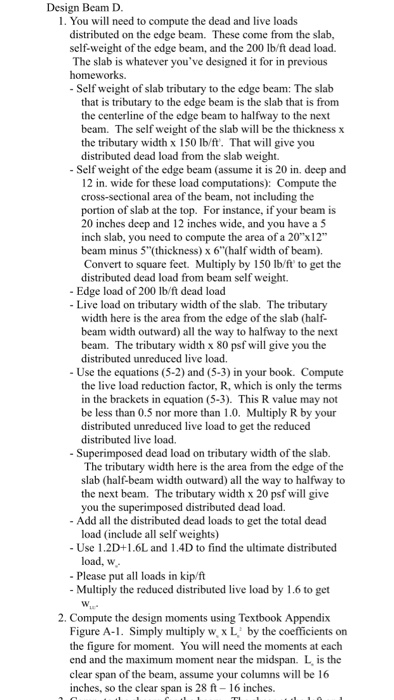Design Beam D. 1. You will need to compute the dead and live loads distributed on the edge beam. These come from the slab, self-weight of the edge beam, and the 200 lb/ft dead load. The slab is whatever you've designed it for in previous homeworks. - Self weight of slab tributary to the edge beam: The slab that is tributary to the edge beam is the slab that is from the centerline of the edge beam to halfway to the next beam. The self weight of the slab will be the thickness x the tributary width x 150 lb/ft. That will give you distributed dead load from the slab weight. - Self weight of the edge beam (assume it is 20 in deep and 12 in. wide for these load computations): Compute the cross-sectional area of the beam, not including the portion of slab at the top. For instance, if your beam is 20 inches deep and 12 inches wide, and you have a 5 inch slab, you need to compute the area of a 20"x12" beam minus 5"(thickness) x 6"(half width of beam). Convert to square feet. Multiply by 150 lb/ft to get the distributed dead load from beam self weight. - Edge load of 200 lb/ft dead load - Live load on tributary width of the slab. The tributary width here is the area from the edge of the slab (half- beam width outward) all the way to halfway to the next beam. The tributary width x 80 psf will give you the distributed unreduced live load. - Use the equations (5-2) and (5-3) in your book. Compute the live load reduction factor, R, which is only the terms in the brackets in equation (5-3). This R value may not be less than 0.5 nor more than 1.0. Multiply R by your distributed unreduced live load to get the reduced distributed live load. - Superimposed dead load on tributary width of the slab. The tributary width here is the area from the edge of the slab (half-beam width outward) all the way to halfway to the next beam. The tributary width x 20 psf will give you the superimposed distributed dead load. - Add all the distributed dead loads to get the total dead load (include all self weights) - Use 1.2D+1.6L and 1.4D to find the ultimate distributed load, w - Please put all loads in kip/ft - Multiply the reduced distributed live load by 1.6 to get 2. Compute the design moments using Textbook Appendix Figure A-1. Simply multiply wxLby the coefficients on the figure for moment. You will need the moments at each end and the maximum moment near the midspan. L is the clear span of the beam, assume your columns will be 16 inches, so the clear span is 28 ft - 16 inches. Design Beam D. 1. You will need to compute the dead and live loads distributed on the edge beam. These come from the slab, self-weight of the edge beam, and the 200 lb/ft dead load. The slab is whatever you've designed it for in previous homeworks. - Self weight of slab tributary to the edge beam: The slab that is tributary to the edge beam is the slab that is from the centerline of the edge beam to halfway to the next beam. The self weight of the slab will be the thickness x the tributary width x 150 lb/ft. That will give you distributed dead load from the slab weight. - Self weight of the edge beam (assume it is 20 in deep and 12 in. wide for these load computations): Compute the cross-sectional area of the beam, not including the portion of slab at the top. For instance, if your beam is 20 inches deep and 12 inches wide, and you have a 5 inch slab, you need to compute the area of a 20"x12" beam minus 5"(thickness) x 6"(half width of beam). Convert to square feet. Multiply by 150 lb/ft to get the distributed dead load from beam self weight. - Edge load of 200 lb/ft dead load - Live load on tributary width of the slab. The tributary width here is the area from the edge of the slab (half- beam width outward) all the way to halfway to the next beam. The tributary width x 80 psf will give you the distributed unreduced live load. - Use the equations (5-2) and (5-3) in your book. Compute the live load reduction factor, R, which is only the terms in the brackets in equation (5-3). This R value may not be less than 0.5 nor more than 1.0. Multiply R by your distributed unreduced live load to get the reduced distributed live load. - Superimposed dead load on tributary width of the slab. The tributary width here is the area from the edge of the slab (half-beam width outward) all the way to halfway to the next beam. The tributary width x 20 psf will give you the superimposed distributed dead load. - Add all the distributed dead loads to get the total dead load (include all self weights) - Use 1.2D+1.6L and 1.4D to find the ultimate distributed load, w - Please put all loads in kip/ft - Multiply the reduced distributed live load by 1.6 to get 2. Compute the design moments using Textbook Appendix Figure A-1. Simply multiply wxLby the coefficients on the figure for moment. You will need the moments at each end and the maximum moment near the midspan. L is the clear span of the beam, assume your columns will be 16 inches, so the clear span is 28 ft - 16 inches







